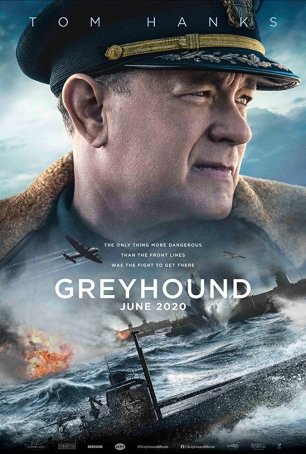Greyhound (United States/Canada/China, 2020)
July 18, 2020
Greyhound is an atypical film: a World War II
thriller that doesn’t aspire to be an epic. Most productions set during the
early 1940s – even those made by blockbuster-minded directors – carry running
times that are as bloated as their grandiose ambitions. Greyhound,
however, is a more precise, intimate experience – an account of the moves and
countermoves executed by the captain of the USS Keeling (codenamed
Greyhound) during a North Atlantic crossing in early 1942. By limiting
character development to a bare minimum – aside from his religious beliefs and
his desire to marry his sweetheart, Commander Ernest Krause (Tom Hanks) is a
mostly generic personality. His combat actions, however, which are presented in
detail, are anything but generic.
Employing an actor with Hanks’ inherent likability offers a useful shortcut in establishing audience identification. Hanks’ reputation fills in many of the blanks left in the screenplay, “tricking” audiences into thinking we know more about Krause than the movie presents. This allows for less background, enabling the movie to get into the story more quickly. Aside from Krause and perhaps XO Charlie Cole (Stephen Graham), the movie is littered with anonymous, interchangeable faces.
 Greyhound is a submarine film presented from the
perspective of those aboard a destroyer. Most of the expected stylistic devices
– the claustrophobic atmosphere, the ratcheting up of tension, the surges of
danger – are present but, instead of the characters being confined under the
water in a long cigar tube, they are trapped on a boat floating atop the waves,
seeking to peer beneath the surface and identify the danger lurking fathoms
below. Despite this flipping of the typical scenario, the film works
surprisingly well. Or at least that’s the case until the strangely
anticlimactic final 15 minutes.
Greyhound is a submarine film presented from the
perspective of those aboard a destroyer. Most of the expected stylistic devices
– the claustrophobic atmosphere, the ratcheting up of tension, the surges of
danger – are present but, instead of the characters being confined under the
water in a long cigar tube, they are trapped on a boat floating atop the waves,
seeking to peer beneath the surface and identify the danger lurking fathoms
below. Despite this flipping of the typical scenario, the film works
surprisingly well. Or at least that’s the case until the strangely
anticlimactic final 15 minutes.
Although not strictly based on specific historical events, Greyhound takes its inspiration from real-life incidents from the Battle of the Atlantic as detailed in C.S. Forester’s 1955 novel, The Good Shepherd. In distilling the essence of the 270-page book into something suitable for a movie, screenwriter Tom Hanks elected to focus on the combat elements. As such, although director Aaron Schneider generates and maintains suspense, he does so from a distance. The various ships are as much characters as the men controlling them. The “villain,” a German U-boat called Grey Wolf, is represented by a disembodied voice.
 For Krause, a career Navy officer on his first wartime
assignment, the mission is to guide a convoy of 37 Allied ships across the
Atlantic to Liverpool. In addition to Krauss’ USS Keeling, the escort group
is comprised of the British destroyers HMS James (“Harry”) and HMS
Victor (“Eagle”), and the Canadian HMCS Dodge (“Dickie”). Once the
ships enter the “Black Pit,” the part of the ocean where there is no protective
air cover, they become prey for German U-boats. After emerging victorious
following the first enemy encounter, Krause discovers that they have attracted
the attention of a “pack” and, as with any hunt, a cat-and-mouse game ensues
with the attackers picking off random members of the convoy seemingly at will
while taunting the four warships using ship-to-ship radio.
For Krause, a career Navy officer on his first wartime
assignment, the mission is to guide a convoy of 37 Allied ships across the
Atlantic to Liverpool. In addition to Krauss’ USS Keeling, the escort group
is comprised of the British destroyers HMS James (“Harry”) and HMS
Victor (“Eagle”), and the Canadian HMCS Dodge (“Dickie”). Once the
ships enter the “Black Pit,” the part of the ocean where there is no protective
air cover, they become prey for German U-boats. After emerging victorious
following the first enemy encounter, Krause discovers that they have attracted
the attention of a “pack” and, as with any hunt, a cat-and-mouse game ensues
with the attackers picking off random members of the convoy seemingly at will
while taunting the four warships using ship-to-ship radio.
Those who want an impeccably detailed war movie or something rich in character development won’t find it here. (Note: for anyone desirous to learn more about the fictitious Krause, the novel fills the need – it’s written entirely from his perspective.) This is a lean, stripped-down example of a more old-fashioned kind of war movie. Putting aside the prolonged ending (the final battle ends with about a quarter hour left on the clock), Hanks’ script is an example of economical storytelling and the end result is a thrilling 75 minutes of the kinds of things one expects from well-made submarine movies.
Greyhound (United States/Canada/China, 2020)
Cast: Tom Hanks, Elisabeth Shue, Stephen Graham, Matt Helm, Rob Morgan, Travis Quentin
Screenplay: Tom Hanks, based on “The Good Shepherd” by C.S. Forester
Cinematography: Shelly Johnson
Music: Blake Neely
U.S. Distributor: Sony/Apple TV+
U.S. Release Date: 2020-07-10
MPAA Rating: "PG-13" (War Violence, Profanity)
Genre: War/Thriller
Subtitles: none
Theatrical Aspect Ratio: 2.35:1
- (There are no more better movies of this genre)
Comments